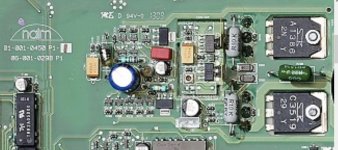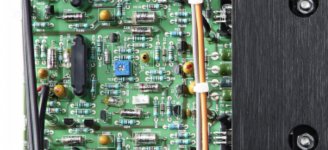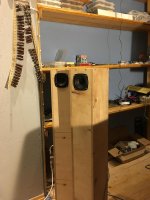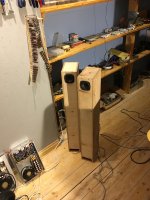Member
Joined 2009
Paid Member
I really can not tell the difference between ceramic or polystyrene if used in these positions
I use ceramic often, but only the np0 type.
Capacitors are important. The NAP200DR, for example, uses plenty of polystyrene and tantalum, with ceramic and electrolytic only in the protection circuitry, as far as I can see from photos.
The Miller cap is important and Naim uses polystyrene. Teflon would be fine too.
The feedback dc blocking cap is solid tantalum and it needs to be high voltage, like 35V to avoid reverse bias damage. Tantalums are easily damaged so I recommend temporarily using a bipolar electrolytic during initial testing.
Every semiconductor is different even if it has the same part number. They are not consistent like resistors. So Naim individually selects parts for specific attributes (the recipe is not publicly available). This is why no eBay kit is going to have the Naim “magic”.
Naim also takes a lot of care with basics like grounding and electromagnetic noise. They appear to use all or mostly non-ferrous enclosures. More recently they have gone crazy with mechanical isolation of circuit boards (transistors and capacitors can be microphonic).
The Naim design is clever but not perfect. Even Naim misses some tricks. I think the original design is extraordinary in its sound quality to manufacturing cost ratio.
I don’t know when but I heard that some years ago they ran into financial troubles due to some unsuccessful product launches and ended up getting venture capital funding. I imagine this is when the white coats and flashy marketing kicked in, with more focus on style and consumer convenience. I still think their stuff is ugly but now it doesn’t have the excuse of deliberate minimalism to focus cost on things that affect sound quality.
The Statement is a radical departure from Vereker Land. They appear to have thrown their own rule book out of the window and brought in more mainstream design. I gather it uses complementary output stages, local output stage NFB, no global NFB and weird custom power transistors that use paralleled dies. I heard they had trouble with the original prototypes not sounding very good and had to have a few rethinks; I wouldn’t be surprised if one of them was to remove global NFB. I have not heard the Statement but I gather it has a different sound. Anyhow, I don’t suppose we are going to see a Chinese NAP S1 clone kit on eBay any time soon. 🙂
The Miller cap is important and Naim uses polystyrene. Teflon would be fine too.
The feedback dc blocking cap is solid tantalum and it needs to be high voltage, like 35V to avoid reverse bias damage. Tantalums are easily damaged so I recommend temporarily using a bipolar electrolytic during initial testing.
Every semiconductor is different even if it has the same part number. They are not consistent like resistors. So Naim individually selects parts for specific attributes (the recipe is not publicly available). This is why no eBay kit is going to have the Naim “magic”.
Naim also takes a lot of care with basics like grounding and electromagnetic noise. They appear to use all or mostly non-ferrous enclosures. More recently they have gone crazy with mechanical isolation of circuit boards (transistors and capacitors can be microphonic).
The Naim design is clever but not perfect. Even Naim misses some tricks. I think the original design is extraordinary in its sound quality to manufacturing cost ratio.
I don’t know when but I heard that some years ago they ran into financial troubles due to some unsuccessful product launches and ended up getting venture capital funding. I imagine this is when the white coats and flashy marketing kicked in, with more focus on style and consumer convenience. I still think their stuff is ugly but now it doesn’t have the excuse of deliberate minimalism to focus cost on things that affect sound quality.
The Statement is a radical departure from Vereker Land. They appear to have thrown their own rule book out of the window and brought in more mainstream design. I gather it uses complementary output stages, local output stage NFB, no global NFB and weird custom power transistors that use paralleled dies. I heard they had trouble with the original prototypes not sounding very good and had to have a few rethinks; I wouldn’t be surprised if one of them was to remove global NFB. I have not heard the Statement but I gather it has a different sound. Anyhow, I don’t suppose we are going to see a Chinese NAP S1 clone kit on eBay any time soon. 🙂
Regarding affordable Naim amplification, there are crossover products like XS2 that retain film caps but virtually all films are eliminated in the Nait i5. We are back to chips and electrolytic caps and the single polystyrene cap that remains in each power amplifier is apparently used for RF bypass at the input. 'Interesting that the infamous output resistor seems to have bitten the dust too 🙄
This alleged Nait 5si image is blurry but shows a couple of polystyrenes, a couple of tantalums and an electrolytic in the feedback.
The 250 or higher is probably the best one to draw conclusions from as the lesser models have increasingly worse parts and, as you say, omitted parts in order to reduce cost and make them sound worse. AS DIY'ers we don't need to worry about manufacturing cost and we seek the best performance.
The 250 or higher is probably the best one to draw conclusions from as the lesser models have increasingly worse parts and, as you say, omitted parts in order to reduce cost and make them sound worse. AS DIY'ers we don't need to worry about manufacturing cost and we seek the best performance.
Attachments
Here's the NAP250-DR up close. Plenty of PS and tantalum as expected. This has the 0.22 ohm speaker output resistor as does the Nait 5si (previous post).
the-evolution-of-the-nap-250
the-evolution-of-the-nap-250
Attachments
Member
Joined 2009
Paid Member
Polystyrene was used in the early days for high performance applications and is still a good choice. But times have changed. The quality of ceramic np0 is now superb, the multi-layer caps rival many film caps and at the top of the pyramid the differences are hardly relevant for us - using FR4 boards etc. As a result of the shift in technical performance, polystyrene caps are less common, they are therefore not as easy to find and relatively expensive. Solder them with care. Aluminium electrolytics have improved the most, the quality of good Al caps today bears no relation to what was available back 'in the day'. Many audio preferences have survived over the years, but they deserve healthy skepticism. Tantalum is the odd one here, but it has a distortion profile that is part of the old Naim sound.
@Bigun, You seem to be implying that Naim are using more expensive polystyrene instead of NP0 because of tradition. I'm sure they would find manufacturing much easier if they used SMD ceramic parts. Could there be something you are not aware of?
I agree this may be too fussy when it comes to eBay kits given the semiconductors and other parts are probably not chosen with care. But it seems to me that a fussy DIY'er may wish to swap the capacitors that come with their kit for the types the NAP250DR uses; it should be all upside for sound quality. If polystyrene are unobtainable then teflon, polypropylene next then perhaps ceramic NP0. And it highly depends on the location. The VAS/Miller is most sensitive. The input RF filter and lead compensation cap are less critical. The driver base networks doesn't matter so much and the network resistor values will be wrong anyhow. But unless cost or availability is a limiting factor then why not just copy Naim?
🙂
I agree this may be too fussy when it comes to eBay kits given the semiconductors and other parts are probably not chosen with care. But it seems to me that a fussy DIY'er may wish to swap the capacitors that come with their kit for the types the NAP250DR uses; it should be all upside for sound quality. If polystyrene are unobtainable then teflon, polypropylene next then perhaps ceramic NP0. And it highly depends on the location. The VAS/Miller is most sensitive. The input RF filter and lead compensation cap are less critical. The driver base networks doesn't matter so much and the network resistor values will be wrong anyhow. But unless cost or availability is a limiting factor then why not just copy Naim?
🙂
Last edited:
The Nait 5si uses a can electrolytic instead of tantalum in the feedback network. It still sounds like a Naim. Explain that.Tantalum is the odd one here, but it has a distortion profile that is part of the old Naim sound.

Member
Joined 2009
Paid Member
I'd be more than willing to believe that Naim knows more than I about the factors affecting choice of cap. I'm talking only from my limited experience, from reading of the experience of other people, of looking at data sheets and by being aware of old reports based on old technology vs modern advances. But audio is a hobby that is part engineering and part magic so 'reason' for parts choices by manufacturers is not always fathomable.
I have found that the VAS compensation has a surprising impact on the sound signature of a traditional feedback amp. Hugh Dean prefers silver mica. I would be willing to believe that any compensation cap has an impact on sound (i.e. not just the traditional Cdom form of compensation). In my early years in this hobby, the surprise for me was the impact of changing the Cdom value, still within the range needed for stability. The Cdom is actually two caps, one is the parasitic Cob of the transistor, the other external Cdom cap. For the NAP the choice of transistor is a weird one. It uses one with a very high parasitic Cdom - i.e. a really crap transistor! This parasitic capacitor has terrible dielectric properties in comparison with np0/film and I believe it is this that is key for the sound so that choice of external Cdom is not really that critical. A design with a very low Cob transistor has very low parasitic Cdom, this is the traditional choice and the external cap then dominates the performance. I have compared silver mica with np0 and find that the np0 is slightly cleaner, this of course with a 'sighted test' and all it's limitations.
I don't know the Nait 5, but there are plenty of places to put tantalum caps if you want to capture their sound signature. My TGM3 amplifier used a tantalum on the input but not in the feedback and the sound was really nice. I suspect the Nait 5 sounds better with the non-tantalum cap in the feedback network and that's why they make it that way. Does it have a tantalum at the input ?
I have found that the VAS compensation has a surprising impact on the sound signature of a traditional feedback amp. Hugh Dean prefers silver mica. I would be willing to believe that any compensation cap has an impact on sound (i.e. not just the traditional Cdom form of compensation). In my early years in this hobby, the surprise for me was the impact of changing the Cdom value, still within the range needed for stability. The Cdom is actually two caps, one is the parasitic Cob of the transistor, the other external Cdom cap. For the NAP the choice of transistor is a weird one. It uses one with a very high parasitic Cdom - i.e. a really crap transistor! This parasitic capacitor has terrible dielectric properties in comparison with np0/film and I believe it is this that is key for the sound so that choice of external Cdom is not really that critical. A design with a very low Cob transistor has very low parasitic Cdom, this is the traditional choice and the external cap then dominates the performance. I have compared silver mica with np0 and find that the np0 is slightly cleaner, this of course with a 'sighted test' and all it's limitations.
I don't know the Nait 5, but there are plenty of places to put tantalum caps if you want to capture their sound signature. My TGM3 amplifier used a tantalum on the input but not in the feedback and the sound was really nice. I suspect the Nait 5 sounds better with the non-tantalum cap in the feedback network and that's why they make it that way. Does it have a tantalum at the input ?
Last edited:
The Nait 5si (see photo in earlier post) appears to use a tantalum on the input. However, it has a smaller value and so is significantly less expensive than a tantalum for the NFB dc blocker. Also, they need to degrade the Nait somehow.
Last edited:
The SuperNait, their most expensive integrated, uses tantalums for both input and NFB dc blocking.
It is funny, but just a couple of days ago I did another advisory job for Nero/Nytech-Audio and in this research I found out again that indeed the VAS compensation cap mattered a lot soundwise. Not was it only a relativly tiny sweetspot for the value (a few pF!), but also the kind of cap changed the sound somewhat significantly. Not night and day, but nevertheless. I still like the polystyrene cap best, better than ceramics. But we found different output transistors (!) which made this cap expendable at all finally.
(The Nero/Nytechs use sophistically updated but still basically the same old schematics like the original ones. The original NAP schematics are different, but also pretty simple, and therefore very critical in every detail.)
(The Nero/Nytechs use sophistically updated but still basically the same old schematics like the original ones. The original NAP schematics are different, but also pretty simple, and therefore very critical in every detail.)
i have three old nytech and i have the same result than the naim with caps and transistors .for Nero/Nytech- indeed the VAS compensation cap mattered a lot soundwise. Not was it only a relativly tiny sweetspot for the value (a few pF!), but also the kind of cap changed the sound somewhat significantly. Not night and day, but nevertheless. I still like the polystyrene cap best, better than ceramics.
(The Nero/Nytechs use sophistically updated but still basically the same old schematics like the original ones. The original NAP schematics are different, but also pretty simple, and therefore very critical in every detail.)
if you have not the original parts,the sound is different ,not big difference but different
i have three old nytech and i have the same result than the naim with caps and transistors .
if you have not the original parts,the sound is different ,not big difference but different
I agree. Nevertheless the new Nero/Nytechs do actually sound better than the old ones, there are certain ways how they can be improved. The time comsuming trick is to find out what can be changed or improved, and what has to be left alone. Almost every part seem to count.
Unfortunately Naim also seem to use some part selection process to get the sound the way they want. While we succeeded to improve the Nytechs, I personally have failed with my attemps to clone Naims, not even to improve them. I admit that I did not try my luck with one of the chinese clones. Not yet.
Member
Joined 2009
Paid Member
Sorry for offtopic:
I made this speakers for reference yesterday:
needle cyburgs
Small rooms will love needle's. Only drawback is the High's... they are kinda distorded, but not in a discusting way, its FRS-8 3.3" 8OHM
It seems that low end bass is out of phase with higher signals, still not discusting.
End results is great, nothing is disturbing or discusting... just different 🙂)
ATM, LM1875T drives everything i got here😛
FRS8 cyburgs are very Good for Television sets.
About highs... Close Original naim clone, not just some clone, have very soft touch high freq. reproduction... i will pair them later with naim amp circuit...to see if something gets different😛
I made this speakers for reference yesterday:
needle cyburgs
Small rooms will love needle's. Only drawback is the High's... they are kinda distorded, but not in a discusting way, its FRS-8 3.3" 8OHM
It seems that low end bass is out of phase with higher signals, still not discusting.
End results is great, nothing is disturbing or discusting... just different 🙂)
ATM, LM1875T drives everything i got here😛
FRS8 cyburgs are very Good for Television sets.
About highs... Close Original naim clone, not just some clone, have very soft touch high freq. reproduction... i will pair them later with naim amp circuit...to see if something gets different😛
Attachments
Last edited:
Member
Joined 2009
Paid Member
I like those strips of capacitors. If you sling them across your chest and buckle up a holster with six-shooters you'd be ready for a Clint Eastwood movie 🙂
Damien Martin ( Spectral, Constellation Audio) has found silver mica to have 30db higher distortion than good polystyrene capacitors ( Blowtorch thread looking at distortion analysers).
Walt Jung and Richard Marsh concur.
Picking Capacitors - Walter G. Jung and Richard Marsh
Cyril Bateman - prefers polystyrene film foil over ceramic as well
http://www.collinsaudio.com/Prosound_Workshop/Capacitor-Sound.pdf
Tantalum caps are so 1970s - better designs today do without coupling caps period.
My system dac, phono, line amp , power amp etc - all dc coupled, all with polystryrence compensation caps, all with dc protect circuits, ten years without an issue
Walt Jung and Richard Marsh concur.
Picking Capacitors - Walter G. Jung and Richard Marsh
Cyril Bateman - prefers polystyrene film foil over ceramic as well
http://www.collinsaudio.com/Prosound_Workshop/Capacitor-Sound.pdf
Tantalum caps are so 1970s - better designs today do without coupling caps period.
My system dac, phono, line amp , power amp etc - all dc coupled, all with polystryrence compensation caps, all with dc protect circuits, ten years without an issue
Last edited:
- Home
- Amplifiers
- Solid State
- NAP-140 Clone Amp Kit on eBay




